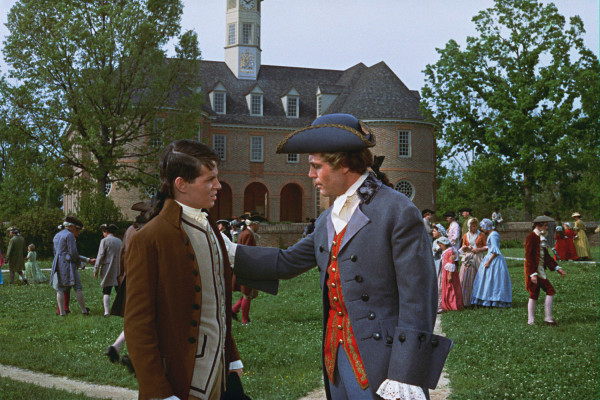
By itself the steel case weighs at least 25 pounds, apt protection for what is widely considered the longest running film in motion picture history. Inside is a print of Williamsburg: The Story of a Patriot. It’s on its way to Chicago’s Music Box Theatre, where it will be shown on March 5 during the 70mm Film Festival.
To mark the occasion, here are some facts about this classic that any cinephile will appreciate.
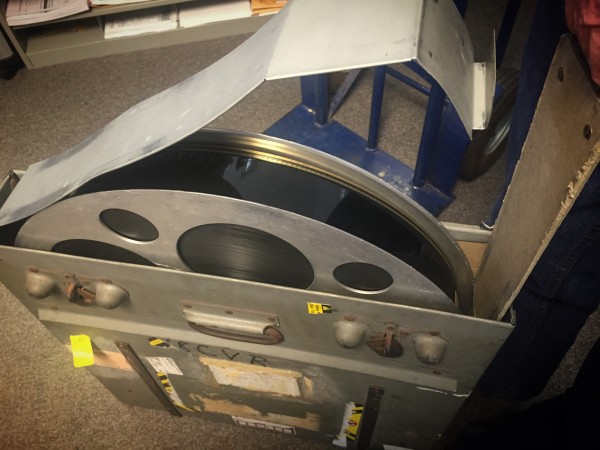
The vision was groundbreaking. Rather than orienting guests with a filmstrip and a map, the plan was to set the mood by telling a dramatic story that would more deeply inform their visit to the Historic Area. It was assumed that it might suffice for five or ten years, after which a new orientation film would likely replace it. No one imagined it would be still be shown after more than half a century.
The first two drafts of the movie to be shown at Colonial Williamsburg’s “ICA,” or Information Center Auditorium, were written by James Agee, who co-authored Let Us Now Praise Famous Men and the screenplay for The African Queen, among other works. But he died while riding in a cab in New York City in 1955, and the script ended up being rewritten from scratch.
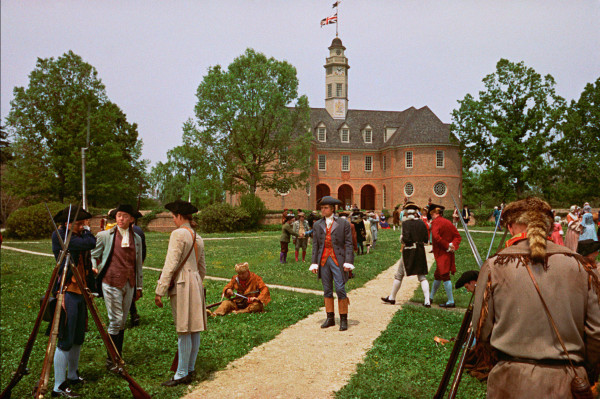
Many people know that The Story of a Patriot featured Jack Lord in the leading role, more than a decade before Hawaii Five-O made him a household name. But this wasn’t just a future star cutting his teeth on a modest local production. Paramount Pictures production already boasted impressive resumes.

Director George Seaton started out by co-writing the Marx Brothers’ A Day at the Races in 1937. Among his directing credits were Miracle on 34th Street and The Country Girl, two movies for which he also won Oscars for screenwriting. Seaton was actually appointed to Colonial Williamsburg’s board, which he served on from 1958 until his death in 1979.

In Spring 1956, there were plenty of women and children in Williamsburg to serve as extras, but finding men available for three weeks of filming proved more difficult. So Seaton approached nearby Eastern State, America’s oldest psychiatric hospital, to fill out the cast. He personally wrote up biographies for 30 members of the House of Burgesses and met with each of the newly minted actors about their roles. Seaton thanked the hospital by premiering The Story of a Patriot there early in 1957.
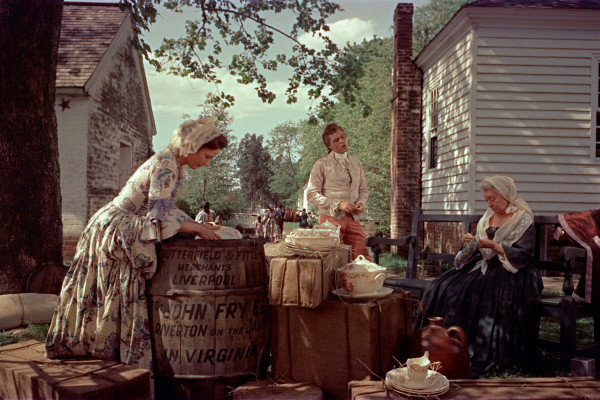
The Story of a Patriot is not technically a 70 mm film. It was produced in Vista Vision, a relatively short-lived method created by Paramount Pictures in 1951. In Vista Vision, the film was run through the projector sideways to produce a larger, more spectacular image. IMAX films today employ the same principle. It also had six-track stereo sound, what today we would call surround sound.
The film itself came from the lab in four reels which our projectionists assembled into a single show reel. “The movie runs on a platter system,” explained Mike Durling, Manager of Digital Media Services. “Three prints sit on a plate which feeds the projector. They are taken up on another plate. The film never needs to be rewound, just rethreaded in the projector every third showing.”
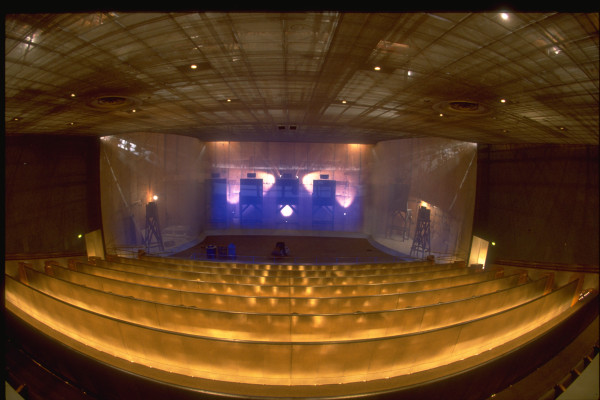
Architects designed the two Visitor Center theaters especially for Vista Vision. The idea was to make every seat the best seat in the house by only putting seats in prime viewing areas. So unlike most theaters, with obvious good and bad seats, the experience is intended to be consistently good in any seat. There are only eight rows with 30 seats apiece.
The rows of seats are divided by short walls that keep the audience free from any distraction and create an immersive experience. You can’t see any of the people in front of you. So what may seem like an oddity was done quite intentionally.
In the photograph above you can see the placement of the speaker system. Five channels originate behind the screen, while the sixth is distributed to several overhead speakers. The theaters were designed to be “acoustically dead,” with little reverberation, an effect intended to make outdoor scenes in particular as realistic as possible.
And here’s the best part: the film was made to suit the theaters. The production crew used a six-foot model of them so they could design shots for that viewing experience. The most apparent result is a lack of close-ups, which would have been jarring to audiences looking at the 52- by 26-foot screen.
The Patriot was a state-of-the-art film when it was produced in 1957, but its colors faded and its edges frayed with thousands of showings over the years. In particular, the yellows had degraded. A painstaking restoration project returned the film to its original vibrancy in 2004.
To date, upwards of 35 million people have viewed Williamsburg: The Story of a Patriot. But its remarkable staying power does not mean it is the same movie we would choose to make today. Like all history, it’s a reflection of the world at the time it was made. It decidedly takes the point of view of Virginia’s gentry leaders, at the expense of wrestling with any difficult subjects like slavery. But it conveys an emotional truth, one which continues to inspire Williamsburg’s visitors as they enter the Revolutionary City.
Every single day of the year.
Special thanks to Mike Durling, who is retiring today after decades of service at Colonial Williamsburg. Among his directing credits and other contributions, he has been keeper of The Story of a Patriot and shared his extensive knowledge for this article.

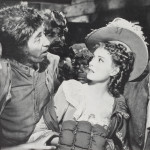
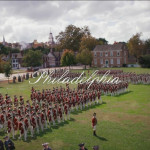
I have seen the film many times on my visits and have collected the post cards made during the making of the film.
I read about the restoration in the early 2000s; where the yellow parts were especially difficult to do.
Looking forward to my next visit as always.
Bruce MacNeil says
I first saw TSOP in 1965, followed by numerous viewings over the next 15 years. During my college years in the late 1970s, I was a costumed interpreter at CW for close to 4 years. (My mother also worked in costume at CW for a number of years.) The thing that struck me most of seeing the restored version a few years ago was seeing the is the opening credits for the first time ever with the wonderful overture and Chester. Never knew that existed as during the period I saw the movie, no opening credits were shown - instead there was a 3-5 minute orientation to CW, then the movie began with the scene of the plantation and the slave boy running towards the house (Tuckahoe plantation). I assume they did show the credits in 1957 to whenever, but I have wondered whose idea it was to remove them, or were they in fact never shown. Also, would love to discuss my memories of the movie and CW with Mr. Sullivan, or anyone else on the blog.
Another film luminary associated with the movie is composer Bernard Hermann, with a score that is nothing like his for Hitchcock films like “Psycho” and “Vertigo”
For 56 years I have loved this film! It tells a “dramatic story” - but it tells the story of how a single individual can make a difference! That is one of the most important messages Colonial Williamsburg imparts. That, and an individual’s RESPONSIBILITY to step up and make a difference. Those solid principles will NEVER become dated, I hope!
Except Christmas day. Christmas movies are normally shown that day, with no need for a ticket.
I purchased this film and two of our grand children watched it in the car on our trip, their first, to Williamsburg. It was a great way to familiarize them with the place and the history. By the way, they loved the place and want to go back! Thank goodness there it a Colonial Williamsburg run by a great organization.